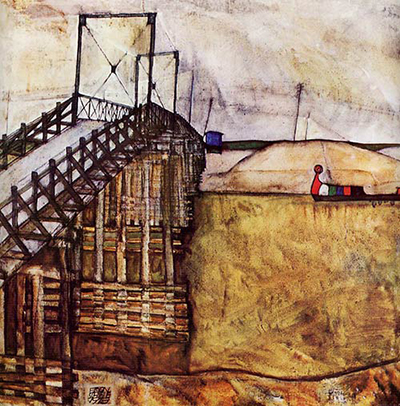Asian stylistic elements found within this beautiful bridge attracted Egon Schiele to produce this painting within his spare time, no doubt taking advantage of the free train travel that he enjoyed for a number of years due to the occupation of his father.
Whilst being an exceptional creative spark, Schiele would sometimes require the diplomatic skills of Gustav Klimt in order to persuade members of high society to employ his services. His personality and artistic style were both more rough around than edges than his colleague, but a little understanding of an artist at work helped Klimt's connections to accept Schiele into their fold. The Lederer family, for example, were hesitant as first but eventually owned a huge amount of Egon's work, including drawings and watercolours. The Bridge came about as an extra artwork completed whilst being commissioned to produce a portrait. He was attracted to the oriental style of this construction and would relax beside it as he studied how to go about capturing it on canvas.
Egon took great care with this painting, amending it throughout 1913 before finally settling upon the completed work. The Bridge was in Gyor, a town in Hungary. It was here that the family estate of the Lederers was located. The artist would lose his father whilst still developing as an artist, but as a station master during his own lifetime Egon would benefit directly from his father's work with free train travel within the local region. This opportunity encouraged him to travel around frequently and he never lost this passion, even after his father had passed away. It is then from that that so many landscape and cityscape paintings would appear, as he attempted to record some of the more intriguing spots that he visited. Schiele also began to implement more expressive moods within his paintings, something that will remind many of the work of the likes of Munch, Van Gogh and also Kirchner.
The Bridge from 1913 can now be found within a private collection, making it hard to access for the general public. Thankfully, many of Schiele's other works can be found dotted around three major art galleries and museums within Vienna, helping to ensure that his career oeuvre remains well understood and appreciated by future generations. It was, of course, this same city which helped the artist to forge an impressive career and so feels entirely right that so much of his output can be discovered here today. Schiele would often find items of interest whilst going about his daily business, which in this case was travelling to produce a portrait of August Lederer. As well paid as he was for that artwork, some might argue that this bonus landscape is actually of more interest today, even though it was not commissioned and produced purely out of enthusiasm.




